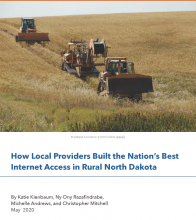Report: Minnesota Communities and Local Providers Build Diverse Solutions for Affordable, Reliable Internet Access
Our new report, Minnesota Broadband: Land of 10,000 Connectivity Solutions [pdf], showcases the diverse range of approaches communities and local Internet Service Providers (ISPs) have taken to expand affordable, high-quality Internet access in Minnesota. It includes a series of case studies that detail how communities are meeting the connectivity challenges of a broken marketplace shaped by large monopoly service providers.
The profiled projects include municipal networks, public-private partnerships, cooperatives, and private investment. They run from the most rural areas of the state to Minneapolis. Some examples include:
- RS Fiber Cooperative, in south central Minnesota, which has brought fiber to local businesses and town residents. Rural residents benefit from RS Air, a fast wireless service available at affordable prices.
- Arrowhead Electric Cooperative’s fiber network in Cook County, which succeeded beyond original projections. It provides fast and affordable Internet access to one of the most far-flung parts of the state.
- St. Louis Park’s partnerships with both ISPs and the builders of large condominium complexes. One of the providers working with St. Louis Park is better known as the fastest ISP in Minneapolis, USI Fiber.
- Christensen Communications, a 100+ year-old telephone company in south central Minnesota. The company demonstrated a strong commitment to its communities when the pandemic hit, and is now going above and beyond to build fiber with federal subsidies.
- The Fond du Lac Band, in northern Minnesota, which built a fiber-to-the-home network that is rare in Indian Country.
Ry Marcattilio-McCracken, co-author of the report and Senior Researcher with ILSR’s Community Broadband Networks initiative, said of the report’s findings:
Minnesota communities and local ISPs have found creative and sustainable ways to build future-proof networks across the state, despite a broken marketplace and state barriers that favor slow-moving, out-of-state monopoly providers clinging to outdated technology. Lawmakers must stand up for the cities and towns that sent them to the legislature, and remove the obstacles that prevent a more competitive market and local broadband solutions.













 Frontier accepted more than $283 million in CAF II funding
Frontier accepted more than $283 million in CAF II funding